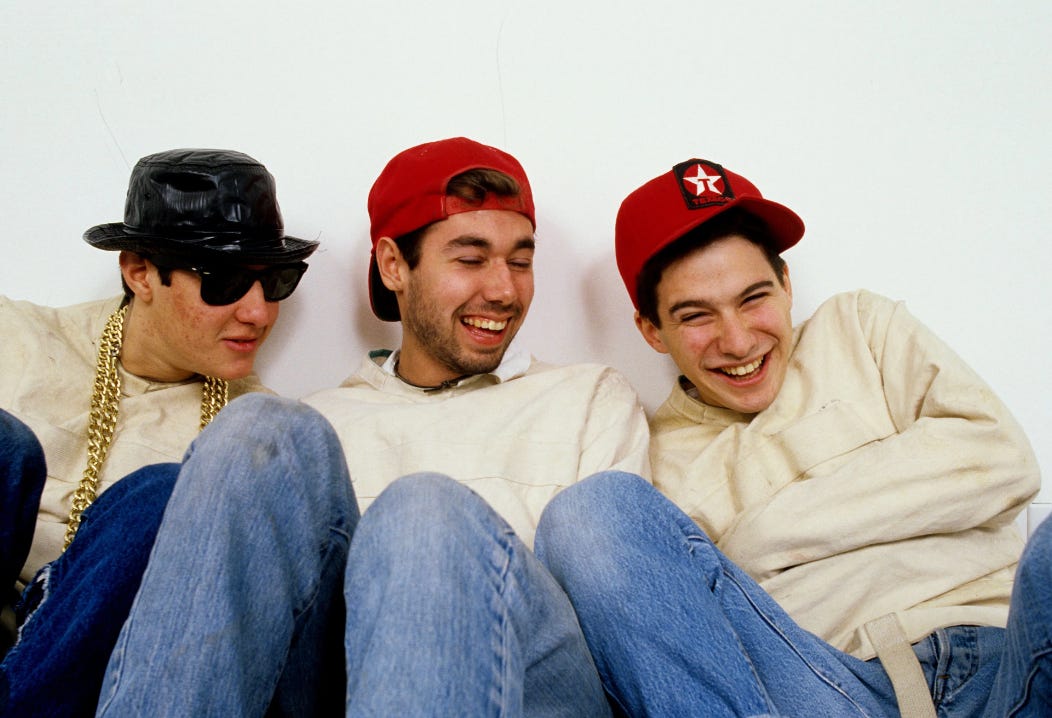Elz | September 10, 2024
The Beastie Boys Edition
On eclectic taste, defining cool, and 'Nevermind'.
Elliot Aronow (EA) is the founder of minor genius and the editor of the minor genius substack. He helps people get paid to be themselves.
Elz here. Before Pinterest, Tumblr, or Shazam, we had the Beastie Boys.
The Beasties were the ultimate curators and culture merchants, although they never perverted their creative universe with gross buzzwords like that.
Between their genre-smashing albums, their iconic videos, their fashion exploits like X-Large, and their magazine Grand Royal, you could say that they were running a “lifestyle brand” of sorts.
The Beasties’ magical gift was that they were able to communicate naturally and unconsciously what corporations spend billions to try and commodify: coolness.
And for me and a whole lot of others, Check Your Head was the Rosetta Stone of coolness.
Why is this interesting?
It may seem quaint to say that there was a time when music was the organizing principle around which youth culture congregated, but looking back at pre-Y2K culture, what you wore, what you ate, and how much you hated the establishment all tied back to your record collection.
It was tribalism on wax.
While a lot of folks peg Nevermind as the quintessential ’90s album, its cultural influence was pretty short-lived. By 1997, the industry had moved on from dirge-y rock, and the fashions felt heavy and outdated.
Check Your Head, on the other hand, landed in the culture as an early indicator of everything that was to come.
The music, which ranges from hardcore thrash (“Time For Livin’”) to lo-fi Marvin Gaye (“Something’s Got To Give”) to alt-rap bangers (“So Watcha Want?”) flows more like a curated playlist by a Supreme employee circa 2025 than it does a major label release.
To the suits, it was eclectic to the point of being “unmarketable.”
Capitol Records had such low expectations for the band after the flop of Paul’s Boutique that they basically ignored them for three years as they recorded a follow up. Left to their own devices, the group ditched a lot of their smartass rockstar poses and repositioned themselves as rootsy lo-fi cultural gourmands.
It proved to be a masterful move that inspired a lot of kids to get their hands dirty and make their own noise.
I think all artists are here to widen our collective permission field. They go out to the fringes and redefine what is possible.
You wanna blend funk and rap and hardcore all on one album? Go for it!
You wanna scour thrift stores for vintage Pumas and all other manner of off brand hipster duds and set fashion trends? Hit it!
You wanna direct your own videos? You can do that, too.
It’s interesting to me that all these years later, it’s become so normal to have a wide-ranging taste in music. But 30 years ago, it was a real subcultural faux-pas to be into so much divergent stuff at once.
Rap heads and indie kids simply did not mix.
Check Your Head took the culture from an “either/or” prison to a THIS/AND conversation.
I’m grateful it came out when it did. It offered us so much and asked very little in return.
Just “be true to yourself and you will never fall.”
Amen. (EA)
-
Why is this interesting? is a daily email from Noah Brier & Colin Nagy (and friends!) with editing help from Louis Cheslaw about interesting things. If you’ve enjoyed this edition, please consider forwarding it to a friend. If you’re reading it for the first time, consider subscribing.
